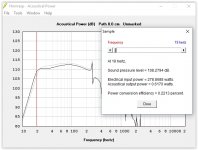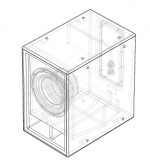Hi YonathanZ,
Post #13: "...The BR needs a high-pass filter, you might get away without one in the CB (closed box)...."
Post #15: "...How do I make a high pass filter for the port itself?..."
As Art said in Post #15 bends will high pass filter an acoustic duct element. I have not found, that a single 90° degree bend influences the vent output much. For an expample look at the picture in Post #5: in the internal side view of the OD-MLTL that TheJessman build I designed in a number of bends between the driver and the terminus (port output).
But, as my quote from Post #13 indicates, I was talking about an electronic HP Filter in front of the driving amplifier, e.g. for your sub: 20Hz HP4 (4th order highpass).
My rule of thumb for bracing is: no unsupported span of more than 8"-10"[20-25cm]. You can use side to side round or square dowels at random position, or more braces with holes cut into them.
See Post #11 for low end extension (the closed box line is very faint on my computer).
Regards,
The graph only allows me to estimate that the -3db point is at 24hz or so.
That's what I get with winISD, which I think I finally got my head wrapped around (it's easier than I thought).
I wanted to see if I could get the -3db point closer to 20hz, and I got it to 22hz with a box of 87 liters (vs 71 litres in the original design).
Makes me wonder how SVS got the -3db point to be at 19hz with a 10" driver on the PB-1000. This sub has a box of 83 litres including the driver and everything. Is this possible to achieve with the 1260W driver?
Hi again,
Try learning Hornresp. 🙂 I find it easier than WinISD - YMMV.
Attached, please, find the SPL comparison V_net=71L v. 87L. Naturally, the lower you tune, the higher the cone excursion for a given input voltage, etc...
This should work too, so you have a bit of a range.
Regards,
Try learning Hornresp. 🙂 I find it easier than WinISD - YMMV.
Attached, please, find the SPL comparison V_net=71L v. 87L. Naturally, the lower you tune, the higher the cone excursion for a given input voltage, etc...
This should work too, so you have a bit of a range.
Regards,
Attachments
Hi again,
Try learning Hornresp. 🙂 I find it easier than WinISD - YMMV.
Attached, please, find the SPL comparison V_net=71L v. 87L. Naturally, the lower you tune, the higher the cone excursion for a given input voltage, etc...
This should work too, so you have a bit of a range.
Regards,
Hornresp looks like a mess to me. What do all these parameters mean? S1, S2, etc...
How did you input the 1260w' parameters into this program?
Hi YonathanZ,
Hornresp has a Help file, well worth printing out...
Soho54 did a nice job writing an introduction to Hornresp, by now a little outdated, but, it should get you started:
Hornresp for Dum... hmm... Everyone 😉 - Home Theater Forum and Systems - HomeTheaterShack.com
Regards,
Hornresp has a Help file, well worth printing out...
Soho54 did a nice job writing an introduction to Hornresp, by now a little outdated, but, it should get you started:
Hornresp for Dum... hmm... Everyone 😉 - Home Theater Forum and Systems - HomeTheaterShack.com
Regards,
Hi YonathanZ,
Forgot to mention: Hornresp has an Import feature, you can import the .txt file from Post #11.
Click on File - Import - Hornresp Record - this will open an Import Hornresp Record window with access to the files in the C:\Hornresp\Import folder (obviously you will have to copy the .txt file into this folder after installing Hornresp).
That might be enough to get you started.
Regards,
Forgot to mention: Hornresp has an Import feature, you can import the .txt file from Post #11.
Click on File - Import - Hornresp Record - this will open an Import Hornresp Record window with access to the files in the C:\Hornresp\Import folder (obviously you will have to copy the .txt file into this folder after installing Hornresp).
That might be enough to get you started.
Regards,
Hi YonathanZ,
Hornresp has a Help file, well worth printing out...
Soho54 did a nice job writing an introduction to Hornresp, by now a little outdated, but, it should get you started:
Hornresp for Dum... hmm... Everyone 😉 - Home Theater Forum and Systems - HomeTheaterShack.com
Regards,
Yes I've read some of it, still looks like Chinese to me though, but thanks.
The initial design was based on a round vent, but I checked 4 hardware stores and couldn't find any PVC pipes that are the right diamater (10cm), so it was decided that I'll let the carpenter make the vent too.
Well, what is the closest diameter you have? It is easy to recalculate using one of the calculators on this sitte: mh-audio.nl - Calculations
Well, what is the closest diameter you have? It is easy to recalculate using one of the calculators on this sitte: mh-audio.nl - Calculations
Sorry, what I meant to say is that I found no hard PVC pipes at all. There was only a 1 cm flexible ("soft") pvc tube.
Why not order Precision Ports?
$43 to ship a 4" port kit to my country. It's way cheaper to have the carpenter do the slot port.
@ YonathanZ
You must be able to find pvc etc pipes in your country. What do they use for rain water etc pipes from the roofs over there ?
You must be able to find pvc etc pipes in your country. What do they use for rain water etc pipes from the roofs over there ?
@ YonathanZ
You must be able to find pvc etc pipes in your country. What do they use for rain water etc pipes from the roofs over there ?
I don't know, I guess I could find it online but building a slot port looks like a cheaper and more elegant solution. Will it make that much of a difference compared to a round vent?
Hi YonathanZ,
I like shelf ports. Here are some suggestions if you want to increase the inlet and outlet areas by adding a little flare (round the corners), and maybe add a corner fillet to the duct corner, and add a center brace.
Regards,
P.S.: Take a look here, examples and port design software:
http://www.subwoofer-builder.com/port-flares.htm
I like shelf ports. Here are some suggestions if you want to increase the inlet and outlet areas by adding a little flare (round the corners), and maybe add a corner fillet to the duct corner, and add a center brace.
Regards,
P.S.: Take a look here, examples and port design software:
http://www.subwoofer-builder.com/port-flares.htm
Attachments
Last edited:
Yonathan,I don't know, I guess I could find it online but building a slot port looks like a cheaper and more elegant solution. Will it make that much of a difference compared to a round vent?
Don't post when on drugs! My previous post had a typographic error, a bent slot port rolls off some of the high frequencies, it is an acoustical low (not high) pass filter.
A slot port can actually be an improvement over a round port, as is the case for the Danley Sound Labs (DSL) CS30 bass reflex (BR) design, which uses a sort of "venturi" port. I have employed a similar approach on a (very) undersized PPSL (push-pull slot loaded) BR, even with it's predicted vent velocity in the mid 30 mps (IIRC) range, the vent noise is not audible over the harmonic distortion.
Have fun, good luck,
Art
Attachments
Hi Art,
I continued with the same mistake. 🙂 But, the electronic filter in front of the drive amplifer is still a HP.
Regards,
I continued with the same mistake. 🙂 But, the electronic filter in front of the drive amplifer is still a HP.
Regards,
A slot port can actually be an improvement over a round port, as is the case for the Danley Sound Labs (DSL) CS30 bass reflex (BR) design, which uses a sort of "venturi" port.
It looks like a "nozzle vent". There's a paper about them in the Internet somewhere.
It can be modelled on HornResp, which makes designing them a bit easier. I haven't designed or built a vented sub in awhile (prefer TH designs at the moment), but if I was to do so, that's the approach I'd take.
Yonathan,
Don't post when on drugs! My previous post had a typographic error, a bent slot port rolls off some of the high frequencies, it is an acoustical low (not high) pass filter.
A slot port can actually be an improvement over a round port, as is the case for the Danley Sound Labs (DSL) CS30 bass reflex (BR) design, which uses a sort of "venturi" port. I have employed a similar approach on a (very) undersized PPSL (push-pull slot loaded) BR, even with it's predicted vent velocity in the mid 30 mps (IIRC) range, the vent noise is not audible over the harmonic distortion.
Have fun, good luck,
Art
Thanks, I'll go with the slot vent.
- Status
- Not open for further replies.
- Home
- Loudspeakers
- Subwoofers
- Opinions on this design?


